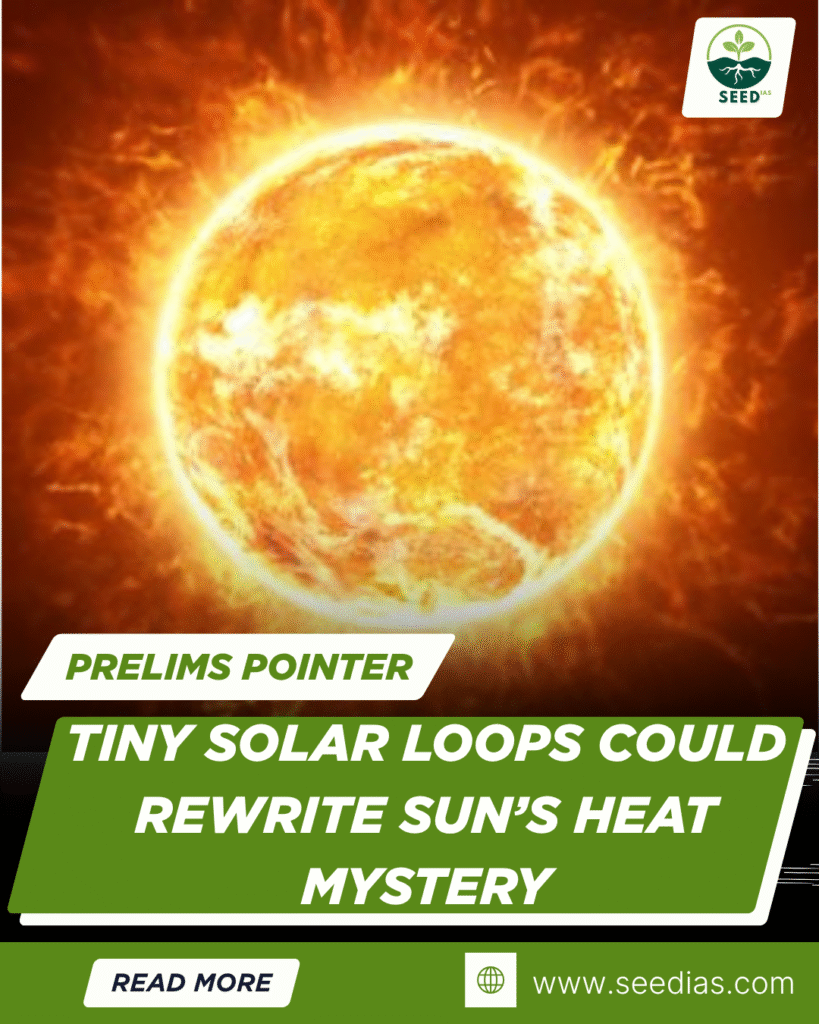Why in NEWS?
Astronomers from the Indian Institute of Astrophysics (IIA) have discovered short-lived miniature plasma loops in the Sun’s lower atmosphere. These structures, previously undetected, could provide new clues on how the Sun stores and explosively releases magnetic energy.
Key Terms and Concepts
| Term | Explanation |
|---|---|
| Miniature Coronal Loops | Small loops of magnetised plasma, 3,000–4,000 km long and <100 km wide, found in the Sun’s chromosphere. |
| Magnetic Reconnection | A process where magnetic field lines rearrange and release energy in the form of plasma jets or flares. |
| Differential Emission Measure (DEM) | A diagnostic technique to determine plasma temperature by analysing solar emissions. |
| Chromosphere | A lower layer of the Sun’s atmosphere, denser than the corona but traditionally cooler. |
What Was Discovered?
| Feature | Detail |
|---|---|
| Location | Sun’s chromosphere (lower atmosphere) |
| Size | 3,000–4,000 km long; <100 km wide |
| Lifespan | Just a few minutes |
| Temperature | Reaches several million degrees Celsius |
| Significance | Indicates powerful energy release through magnetic reconnection even in lower solar layers |
| Associated Phenomena | Linked to small plasma jets; mirror large events like solar flares and CMEs |
Why Is It Important?
| Aspect | Impact |
|---|---|
| Solar Heating Puzzle | Challenges current models that struggle to explain how such high temperatures exist in the Sun’s lower atmosphere. |
| Energy Release Understanding | Reveals that significant magnetic activity occurs much lower than previously believed. |
| Plasma Dynamics | May help understand how tiny loops impact larger solar atmospheric events. |
Role of National Large Solar Telescope (NLST)
| Feature | Detail |
|---|---|
| What is NLST? | Proposed advanced optical and IR telescope by IIA to study the Sun from Ladakh. |
| Purpose | Designed to observe solar magnetic fields and plasma dynamics in high resolution. |
| Future Contribution | Could help detect more miniature loops and understand their role in solar magnetism and coronal heating. |
In a Nutshell
Memory Code: LOOP-HEAT
L – Loops found in chromosphere
O – Only a few minutes long
O – Over a million degrees in temperature
P – Plasma jets from loop tips
H – Heating puzzle: existing models challenged
E – Emission measure shows extreme temperatures
A – Associated with magnetic reconnection
T – Telescope (NLST) to study them further
Prelims Practice Questions
- Miniature coronal loops recently discovered are primarily associated with which of the following solar processes?
A. Nuclear fusion
B. Solar wind formation
C. Magnetic reconnection
D. Sunspot cooling - Which Indian facility is proposed to study solar magnetic fields and optical emissions in high detail?
A. AstroSat
B. NLST
C. ISRO Solar Probe
D. VELC Observatory - The layer of the Sun where the newly discovered miniature plasma loops were detected is called the:
A. Corona
B. Photosphere
C. Chromosphere
D. Core
Mains Practice Questions
- GS3 (Science & Tech):
Explain the significance of discovering miniature plasma loops in the Sun’s chromosphere. How do such discoveries challenge existing solar heating models? - GS3 (Space Technology):
Discuss the role of upcoming Indian solar telescopes like NLST in advancing space weather research and solar observation capabilities.
Answer Key with Explanation
| Q No. | Answer | Explanation |
|---|---|---|
| 1 | C | Magnetic reconnection is the key energy-release mechanism linked to these loops. |
| 2 | B | NLST is India’s proposed facility to study the Sun from Ladakh. |
| 3 | C | The loops were observed in the Sun’s chromosphere, not the corona. |
















